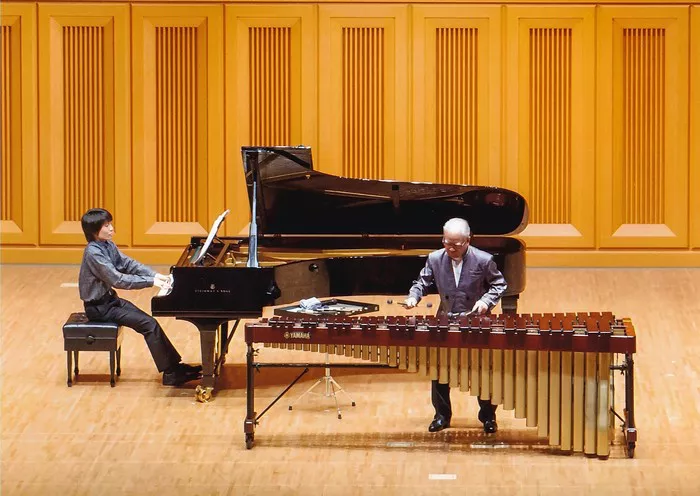In the rich tapestry of global music, the xylophone has woven itself into the fabric of various cultures, captivating listeners with its vibrant tones and rhythmic allure. Among the nations that have embraced the xylophone as an integral part of their musical heritage, Ghana stands out as a shining example. The Ghanaian xylophone, known as the “gyil,” holds a special place in the country’s cultural identity, serving as a conduit for communal expression, storytelling, and spiritual connection. This article delves into the resonant tradition of the xylophone in Ghana, exploring its historical significance, musical variations, and enduring impact.
The Historical Roots of the Ghanaian Xylophone
The origins of the Ghanaian xylophone can be traced back centuries, where it played a pivotal role in the traditional cultures of the Dagara and Lobi ethnic groups. Historically, these xylophones were crafted using locally sourced materials, reflecting the resourcefulness and creativity of the Ghanaian people. The xylophone was not merely an instrument; it was a vessel for passing down oral histories, rituals, and cultural values from generation to generation. The resonance of the xylophone’s notes carried the echoes of antiquity, preserving the collective memory of communities.
Diverse Types of Xylophones in Ghana
Within Ghana’s musical landscape, the xylophone manifests in a variety of forms, each with its unique tonal characteristics and cultural significance. The “gyil,” a marimba-like xylophone, is the most prominent variant. It consists of wooden bars suspended over gourds, which amplify the sound. The gyil is played in ensembles, often accompanied by drums and other instruments. Another xylophone, the “dzama,” is smaller and associated with storytelling and recreational music. Each type of xylophone holds a distinct place in Ghana’s cultural tapestry, contributing to a vibrant mosaic of musical expression.
See Also: Resonating Melodies: Describing the Sound of the Xylophone
The Spiritual Role of the Xylophone
In many Ghanaian communities, the xylophone transcends the realm of entertainment to serve as a conduit for spiritual connection. Rituals, ceremonies, and festivals are often accompanied by the resonant melodies of the xylophone, which are believed to channel the energies of ancestors and deities. The xylophone’s hypnotic rhythms create a meditative atmosphere, facilitating a connection between the earthly and spiritual realms. In this way, the xylophone becomes not just an instrument, but a vessel for transcendence and reverence.
Xylophones as Vehicles of Oral Tradition
Ghanaian xylophones are more than just instruments; they are storytellers. The intricate melodies and rhythms produced by the xylophone convey narratives, legends, and historical accounts. Griots, or oral historians, use the xylophone to accompany their narratives, infusing their stories with emotional depth and authenticity. The xylophone’s ability to evoke emotions and paint vivid auditory images adds a captivating layer to the tales being shared. This marriage of music and storytelling enriches Ghana’s cultural heritage, keeping traditions alive through both sound and word.
The Role of Xylophones in Social Cohesion
The Ghanaian xylophone tradition fosters a sense of community and collaboration. Playing the xylophone often involves coordinated efforts within an ensemble, where players synchronize their rhythms to create a harmonious whole. This collaborative aspect extends beyond the musicians; the audience also becomes an active participant, clapping, dancing, and engaging in call-and-response interactions. The xylophone’s communal nature strengthens social bonds and emphasizes the interconnectedness of individuals within the larger cultural context.
The Xylophone’s Enduring Impact on Ghanaian Culture
The Ghanaian xylophone’s enduring impact on the country’s cultural identity cannot be overstated. It embodies the interconnectedness of music, spirituality, storytelling, and community within Ghana’s diverse tapestry. The xylophone’s resonance carries the voices of ancestors, the heartbeat of traditions, and the aspirations of a nation. Its melodies transcend time, forging a bridge between history and the present, reminding Ghanaians of their roots and offering a source of inspiration for the future.
Conclusion
The Ghanaian xylophone tradition embodies the essence of cultural continuity, bridging past and present, and embracing tradition while evolving with the times. Its resonant melodies serve as a living testament to the power of music to unite, inspire, and uplift. As the xylophone’s harmonies continue to resonate across the landscapes of Ghana, they carry with them the stories, spirits, and aspirations of a nation. In every note struck, the Ghanaian xylophone echoes the heartbeat of a resilient culture, ensuring that its legacy remains vibrant and enduring.


